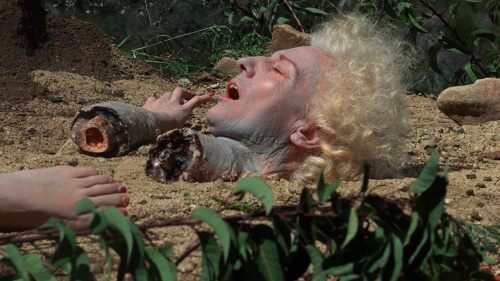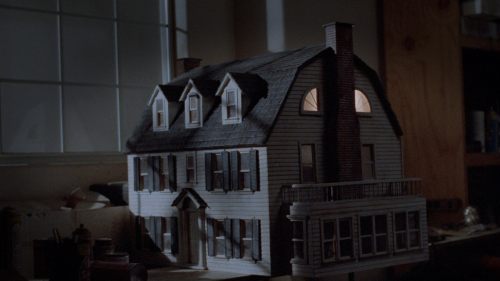Exploitation TV: Volume Seven
For cinephiles, the definition of home video label Vinegar Syndrome’s name is something like a secret handshake. The disease it references consumes celluloid. When film stock starts to degrade, it releases acetic acid, the key ingredient in (you guessed it) vinegar. This phenomenon became a plague during the 80s, chewing up prints of pictures improperly stored in hot, humid conditions. In many cases, where reels of smaller films were scarce due to budgetary restrictions, one bad case of vinegar syndrome could rob the planet of an artist’s work.
According to a ‘12 study conducted by the Library of Congress, only 14% of nearly 11,000 movies made between 1912 and 1930 exist in their original format. Around 70% were lost completely. Coming in at a close second in terms of casualties is the Exploitation Era. This really shouldn’t come as a surprise to anyone, as many of the weirder, more obscure movies made during these decades of disrepute are pictures we’ve probably never heard of in the first place. Thankfully, the Bridgeport, Connecticut boys at VS own a private archive, from which they’ve been pulling and scanning prints of overlooked horror, exploitation and smut cinema from all eras. To make it easier on all us degenerates, they’ve even established a streaming service, where you can log in and watch all the back alley oddities they’ve been uncovering and preserving, so that true vinegar syndrome doesn’t rob us of any more great trash art.
For the seventh edition of Exploitation TV, we continue to celebrate the Halloween Season with three B&W chillers…

The Bat [1959] (d. & w. Crane Wilbur)
A chamberpiece mystery presented with attention to dreamy atmosphere, and featuring a central super fiend whose razor sharp claws will leave your psyche scarred, Crane Wilbur's adaptation of Mary Rinehart and Avery Hopwood's stageplay owns the same love of the whodunit? as the best of Agatha Christie's yellow-paged pulp novels. Lensed by Joseph Biroc - the same versatile DoP who shot It's a Wonderful Life ('46) for Frank Capra - this tale of a bank robber's hidden million and the mansion full of misfits the masked man offs (including Agnes Moorehead's own mystery novelist Christie clone, and Vincent Price's suitably creepy "good doctor") while trying to find his dough is thoroughly entertaining, if far from a classic of the Price oeuvre.
In fact, Price himself stated that he was disappointed in his final film version of The Bat (which was the fourth cinematic adaptation of the play). RKO bought the rights to remake the picture off of Mary Pickford, who had produced the first screen iteration in 1926, and Price signed on because the play had terrified him as a child. However, the famous horror actor is being quite hard on Wilbur's work, as the lush cinematography and Louis Forbes' bombastic, unsubtle score brings all the red-herrings and narrative twists to life with devilish aplomb. By 1959, The Bat had been delivered to matinee marquees so many times that there was no way this was going to be the defining instance of the story's existence. Instead, we get a solid potboiler; fast, cheap, and full of chuckles/gasps.

Castle of Blood (a/k/a Danza Macabra) [1964] (d. Sergio Corbucci & Antonio Margheriti, w. Sergio Corbucci & Giovanni Grimaldi)
The ultimate Italian approximation of a Hammer Horror film, Sergio Corbucci (The Great Silence ['68]) shot for a week before being replaced by Antonio Margheriti (Yor: Hunter From the Future ['83]) on this adaptation of a tale that never was. Castle of Blood is jagged and strange, opening on a tavern meeting with Edgar Allen Poe (Silvano Tranquilli, playing E.A.P. as an eyewitness to the supernatural, as opposed to an author of horror fiction), where a journalist (Georges Rivière) challenges the authenticity of the obvious drunkard's claims. Poe counters by daring the brazen fact-checker to stay in a haunted castle on All Souls Eve, which leads to one of the more bizarre, sensual romances in screen history.
Barbara Steele (Black Sunday ['60]) is a regal ghost, trapped in this Gothic abode due to her unwillingness to let go of the past; a former lover (Giovanni Cianfriglia), her husband (Umberto Raho), and a rival (Sylvia Sorrente) all stuck with her in this cobweb and shadow covered purgatory. Her trio of spectral companions lust for the writers' blood, hoping it can allow them to live beyond this single ceaseless night, and possibly cross back over onto the plane of the living. Scored by sonic maestro Riz Ortolani (Cannibal Holocaust ['80]), Castle of Blood is hypnotically strange, as its otherworldly eroticism injects an odd psychosexual subtext about falling for someone you can never touch, let alone possess. Corbucci and Margheriti may have gone on to become a pair of princes within their country's notorious rip off cinema culture, but here they crafted a work that's ethereal and unsettling, transcending the work its aping by owning a unique rotten texture.

Blood Thirst [1967] (d. Newt Arnold, w. N.I.P Dennis)
A Filipino noir/monster movie/exploitation hybrid where an odd pimple-headed monster preys on the local dancing girls, there's something incredibly striking about the black and white low budget photography, emphasizing the mystery elements, as an American detective (Robert Winston) is called in from New York City by an old Inspector pal (Vic Diaz) to try and decipher just what in the hell is happening to the island's beautiful women. Blood Thirst is jazzy and jangly, never really going anywhere, as sleuthing takes a backseat to cruising around the country with this undercover sex crimes dick, as he lusts after various club ladies who could be the beast's next targets.
This is classic exploitation shenanigans, as a dollar is obviously being stretched to twenty via cheap labor and short end film stock. All of the victims are drained of their plasma, and Diaz's local policeman suspects a blood cult is up to no good. Funny thing is, there obviously wasn't enough money on hand to bring these ideas to life, so we instead get a hangout picture, until the last twenty minutes when Newt Arnold & Co. realize they've got to wrap things up. Shot in '65 and then released in drive-ins and dives six years later in '71, Blood Thirst is an essential Something Weird Video title: charming mostly because you have no idea how to describe what you just watched once the final reel finishes.
Tune in next week for three more picks from your new favorite channel. In the meantime, log in to Vinegar Syndrome’s streaming service to embark upon your own filthy adventures.



